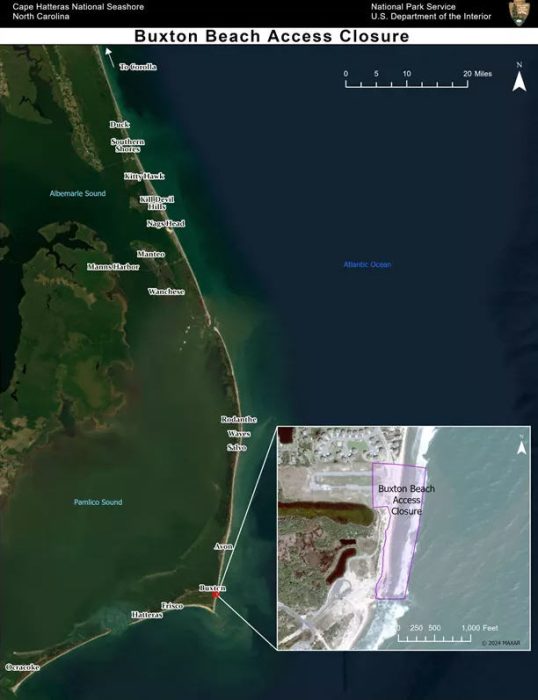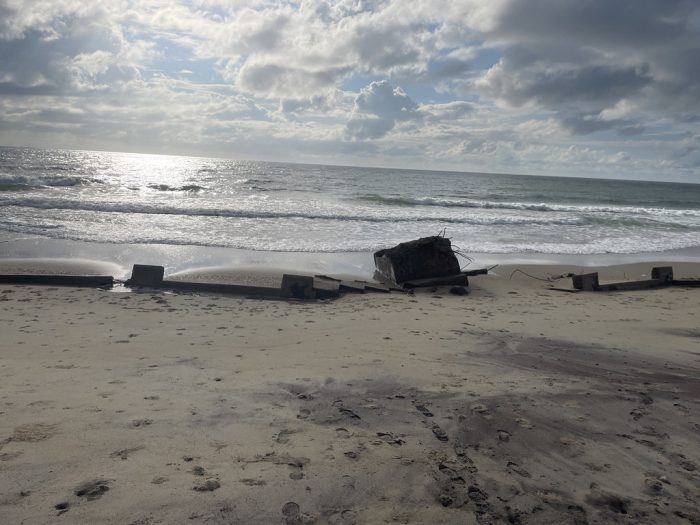
On September 1, 2023, the Cape Hatteras National Seashore (CHNS) issued a temporary closure for a small stretch of Buxton Beach after two offshore hurricanes eroded the shoreline, and exposed leftover infrastructure from a 1956-2010 military base, as well as sporadic but strong petroleum smells.
Since then, the closure has been expanded slightly, from two-tenths to three-tenths of a mile. Reports of petroleum smells drift in with heightened wave and storm activity, and the topic has become a flashpoint of community frustration as residents and visitors wait for a long-term solution.
It may feel like there has been little progress in the past year, but for individuals and organizations who have been wading through the issue for 12 months, this is not necessarily the case.
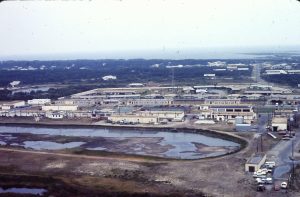
CHNS Superintendent David Hallac has spent thousands of hours on the topic of Buxton Beach in the last year. He communicates regularly with the U.S. Army Corps of Engineers and the U.S. Coast Guard – the two agencies responsible for past military activities at the 50-acre site – as well as the general public.
The Buxton site was the home of a Navy base from 1956-1982, and a U.S. Coast Guard base from 1984-2010, and both military branches signed an agreement with the National Park Service, (the landowner), to leave the site in a natural, pristine condition when they no longer needed the property.
Unfortunately, both branches fell short in past remediation and clean-up efforts, as evident by the debris and infrastructure that remains on the beach today.
Hallac groups the environmental and public safety issues that stem from the military site into four categories – remnant naval contamination (namely leftover petroleum), remnant naval infrastructure, the potential for other contaminants from the U.S. Coast Guard, and remnant Coast Guard infrastructure.
“Knowing that there are two agencies that occupied the site, and three agencies that are managing the site, it’s definitely going to take some time to root through those issues,” said Hallac. “We’re going to have to address each of the four issues separately, so we’re using a ‘what’s important now’ strategy. We want to address the contamination at the site first, and we want to remove these contaminants wherever they exist. Once we manage that, we will move on to the infrastructure.”
“This is not a Hollywood oil spill where there is raw product leaking out, and people can just cap it,” he added. “It’s more complicated than that, and more subtle than that, and it’s possible that there is more than one site [of petroleum/contaminants] as well.”

The biggest hurdle to remediating Buxton Beach is arguably determining the source of the many problems.
The U.S. Army Corps of Engineers (Corps) conducted multiple testing events at various locales throughout the Buxton Beach site over the past year, with mixed results. They removed a pipe that was thought to be a source of petroleum back in May and sent a team to Buxton on June 24-28 to conduct geophysical work in order to identify any potential fuel distribution components, such as pipes or fuel tanks, that still remained under the surface.
But the issues persist, as evident by August’s Hurricane Ernesto, which resulted in a new influx of reports of petroleum smells. While some of the leftover infrastructure is obvious – like the foundation of the Navy’s former Terminal Building which was clearly exposed during a March 2024 storm – the scope of the problem is not.
“When you look at how expansive this site is, and realize that it’s been a long time since the infrastructure was there, in some ways, it’s not surprising that this situation is complicated,” said Hallac. “There were tanks, fuel lines, generators, boilers – it’s challenging to go back to use the clues that we’re seeing today and cross-reference them to the past.
“And when there are [limited] clues about a problem, it becomes harder to define the problem.”
What is happening now
To many Hatteras Islanders and visitors, progress on a full Buxton Beach remediation has been moving at a glacial pace.
However, there is ample reason to be optimistic that this seemingly stagnant movement will change, and will change soon.
In June 2024, the Corps announced that in addition to the geophysical work that occurred this past summer, the agency planned to conduct comprehensive sampling at the site sometime later this year, with the contract expected to be awarded in October, (after the start of the agency’s new fiscal year.)
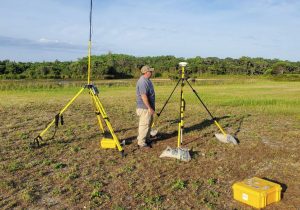
“These next steps were identified after recent investigations and the completion of an internal review by the U.S. Army Corps of Engineers Environmental and Munitions Center of Expertise,” stated the Corps in a June 13 press release. “The review included thorough assessment of data from a site visit, interviews with Army Corps of Engineers, National Park Service, U.S. Coast Guard and contractor personnel, as well as a comprehensive evaluation of approximately 40 documents pertaining to prior and current observations, investigations and corrective actions taken at the FUDS property. The document, called The Strategic Optimization Technical Memorandum, is available here EMCX Report.”
The announcement of more testing – after a year of multiple rounds of testing – may initially seem like white noise.
But this new venture is different, because instead of focusing on a few strategic but still somewhat-random spots on the Buxton property, it will provide an in-depth examination of the issues at hand.
“The Corps is getting ready to implement a fairly comprehensive sampling of the entire site,” said Hallac “This is what we’ve been recommending, and we really appreciate the fact that we’re moving now.
“It has been a while, and I know it has been frustrating to the public, but we have had progress… and I think we are poised now to move much more quickly on diagnosing the problem, and hopefully implement remediation efforts.”

For Hallac and many other individuals and organizations connected to Buxton Beach, the biggest challenge so far, (and the most important next step), is getting comprehensive data to define the problem. It’s very difficult to fix any issues when the exact issues are unknown, which is why the comprehensive testing by the Corps will be such a milestone. “It should serve as the blueprint moving forward,” said Hallac.
Meanwhile, the U.S. Army Corps of Engineers Savannah District Commander, Col. Ron Sturgeon, is set to provide an update about the Buxton Naval Facility during the Dare County Board of Commissioners (BOC) monthly meeting in Manteo on Tuesday, September 3, at 9:00 a.m.
All Dare County BOC meetings can be watched live on Dare County’s YouTube channel and on Spectrum’s Channel 191 (Current TV), and folks can sign up to make public comments at the beginning of every meeting in person in Manteo, or through a video link at the Fessenden Center Annex Building in Buxton. (For more information on the BOC monthly meetings, visit https://www.darenc.gov/departments/board-of-commissioners/meetings.)
The Buxton Civic Association (BCA) will also be hosting its next monthly public meeting on Wednesday, September 4, at 7:00 p.m., at the old Buxton Volunteer Fire Department building next to Burrus Field.
The public is welcome and encouraged to attend, as the meetings provide valuable insight as to what’s happening on a local and national level when it comes to Buxton Beach, as evident by the BCA’s August meeting with guest speakers Hallac and Liz Rasheed, senior associate attorney with Southern Environmental Law Center.
The silver linings of Buxton Beach
For the many individuals and organizations connected to Buxton Beach, the past year has shown what intense community involvement can accomplish.
Hatteras Island’s Dare County Commissioner Danny Couch has been tied to the Buxton Beach issues since they surfaced on September 1, 2023. Hearing from dozens if not hundreds of constituents, Couch has seen first-hand how the island community has rallied to force attention and a solution.
“Even though things appear to be moving excruciatingly slow, they are moving,” said Couch.
“There are a lot of positives about this,” he added. “It’s helping to raise our profile here. We ended up with a recent resilience grant, and I have to think this new environmental focus and outcry had something to do with that.”
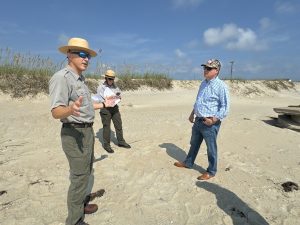
The Buxton Beach issue galvanized the formation of the Buxton Civic Association (BCA) back in the spring of 2024, but the organization’s long-term goals go miles beyond the current environmental issues.
“There are a lot more long-term implications of forming the [BCA],” said Board Member Heather Gray Jennette at the BCA’s inaugural April meeting. “This issue is on fire right now, but this is also about down-the-road plans… Buxton is long overdue for a centralized voice.”
In addition, local letter-writing campaigns, public meetings, and other outreach initiatives to local, state, and federal governments have garnered a wave of interest and response.
Dare County Commissioners Danny Couch, Wally Overman, Chairman Bob Woodard, and County Manager Bobby Outten all went to Washington D.C. in the spring to highlight the Buxton issue to legislators, and Congressman Greg Murphy visited the Buxton site in August, sending out a post-visit press release to demonstrate his commitment to the issue.
And there is a long list of supporting organizations that have heard the outcry of Hatteras Islanders, as well. This includes the Outer Banks Chamber of Commerce, the NCDEQ, the Southern Environmental Law Center, the Outer Banks Association of REALTORs, the North Carolina Coastal Federation, and various legislators who have joined the conversation and demanded an immediate solution for Buxton Beach.
“While it hasn’t been optimal that the Buxton beach was closed for the summer season, I do believe that for a federal environmental challenge of this scope, the discussion has been moving along and progress has been made to get us closer to a clean and safe oceanfront in the coming year,” said Julie Youngman, senior attorney for SELC, in an email to the Island Free Press.
“It is incredibly frustrating to the entire community – residents, businesses, tourists, and environmentalists alike – that the situation on the ground at this beloved national seashore has not changed since last September. Both the applicable laws and historical documents outlining agencies’ responsibilities point to the Army Corps of Engineers as the responsible party for cleaning up the mess. The time has come for the Army to move on from conducting repetitive testing and instead spend their limited funds on prioritizing actual clean up.”
Susan Sigmon and Deb Hoyt – two individuals who helped launch an effective letter-writing campaign in March– share this frustration, but also see the bright side of how the community has stepped up to tackle the problem.
“It would be easy to look at this past year with frustration and a sense of failure regarding the cleanup of Buxton Beach,” said Sigmon. “With that said, I am heartened to think about all the work that has been accomplished towards that goal. Brian Harris and the newly formed Buxton Civic Association have done an amazing job in raising awareness of the issue, along with the steadfast support of Superintendent Hallac and the Dare County Commissioners. The wheels of bureaucracy turn slowly, but they are turning!”
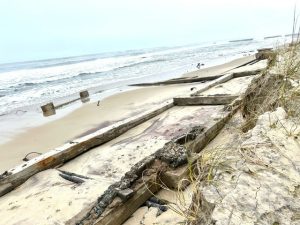
Hoyt also credits the BCA, the Dare County Commissioners, and the National Park Service for their role in finding a solution.
“The cooperation and collaboration of all stakeholders to create a plan to achieve our shared goal of a total resolution was evident during the public meetings and listening session,” said Hoyt. “The execution will take time, but I believe the commitment is there by the federal and state agencies. The Buxton Civic Association will ensure accountability and the Dare County Commissioners and Park Service have provided great leadership to ensure the public’s concerns are heard.”
There’s not a silver-bullet solution to the Buxton Beach problem, but according to the folks on the ground who have been there since day one, there’s ample reason to be positive about what’s on the horizon.
“In terms of what to look out for, we’re optimistic that this comprehensive sampling [by the Corps] will be done soon, and will provide information on how to manage the situation before any significant erosion occurs,” said Hallac.
At the bare minimum, Buxton Beach has demonstrated that Hatteras Islanders have a very resonating and effective voice when they choose to deploy it.
“Some of the good things that have come out of this has been the establishment of a Buxton Civic Association, and the rallying of citizens here and visitors alike,” said Couch. “The islanders are not going anywhere until this is resolved. Their tenacity has been remarkable.”
For more information on Buxton Beach
- The Buxton Civic Association meets monthly at the old Buxton Volunteer Fire Department building beside Burrus Field. The next meeting is Wednesday, September 4, at 7:00 p.m.
- Developing info from the Buxton Civic Association (BCA) can be accessed via the organization’s website at Buxtoncivic.com or through the BCA’s official Facebook page.
- The U.S. Army Corps of Engineers Savannah District Commander, Col. Ron Sturgeon, will provide an update about the Buxton Naval Facility during the Dare County Board of Commissioners (BOC) monthly meeting in Manteo on Tuesday, September 3, at 9:00 a.m. All Dare County BOC meetings can be watched live on Dare County’s YouTube channel and on Spectrum’s Channel 191 (Current TV), and folks can sign up to make public comments at the beginning of every meeting in person in Manteo, or through a video link at the Fessenden Center Annex Building in Buxton.
- Remember that while the environmental issues at Buxton Beach are considered to be a public safety and environmental hazard, just three-tenths of a mile of the shoreline is closed, out of 75 miles of National Seashore. In short, the public can still visit and enjoy Buxton, and Hatteras Island in general. The primary concern is that this issue needs to be addressed now, before it potentially becomes a larger problem.
